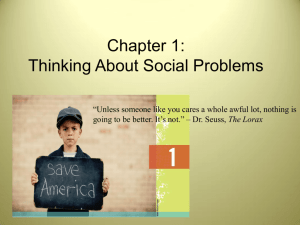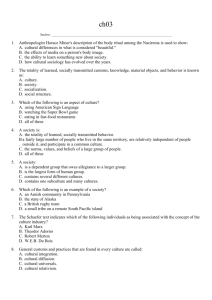Chapter 1
advertisement
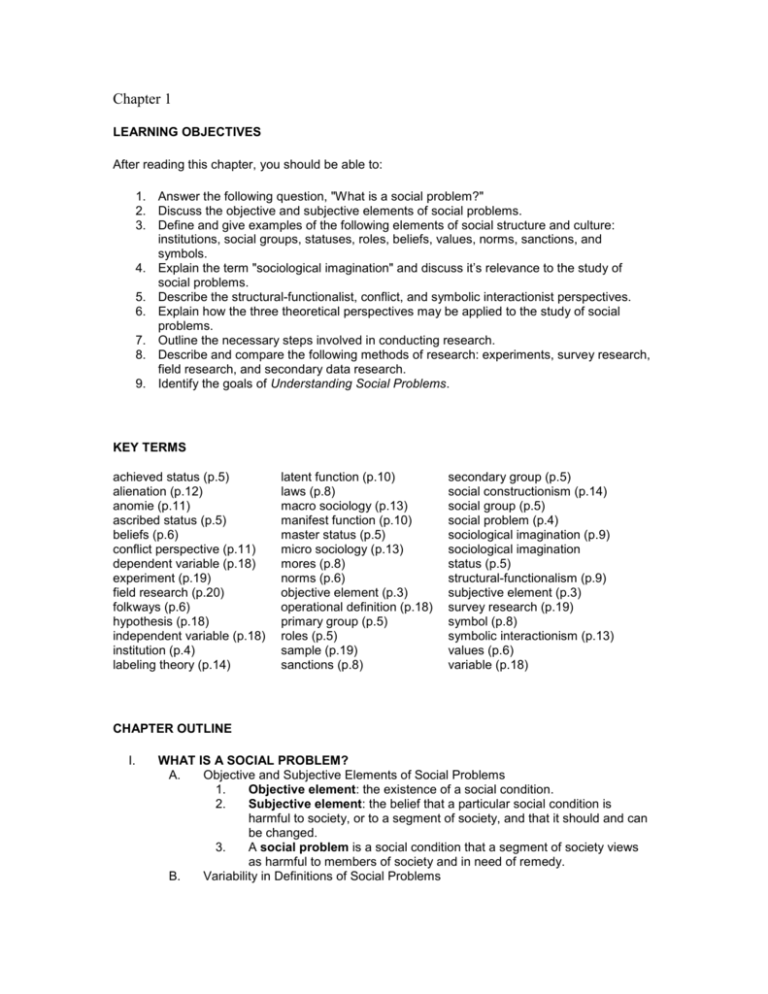
Chapter 1 LEARNING OBJECTIVES After reading this chapter, you should be able to: 1. Answer the following question, "What is a social problem?" 2. Discuss the objective and subjective elements of social problems. 3. Define and give examples of the following elements of social structure and culture: institutions, social groups, statuses, roles, beliefs, values, norms, sanctions, and symbols. 4. Explain the term "sociological imagination" and discuss it’s relevance to the study of social problems. 5. Describe the structural-functionalist, conflict, and symbolic interactionist perspectives. 6. Explain how the three theoretical perspectives may be applied to the study of social problems. 7. Outline the necessary steps involved in conducting research. 8. Describe and compare the following methods of research: experiments, survey research, field research, and secondary data research. 9. Identify the goals of Understanding Social Problems. KEY TERMS achieved status (p.5) alienation (p.12) anomie (p.11) ascribed status (p.5) beliefs (p.6) conflict perspective (p.11) dependent variable (p.18) experiment (p.19) field research (p.20) folkways (p.6) hypothesis (p.18) independent variable (p.18) institution (p.4) labeling theory (p.14) latent function (p.10) laws (p.8) macro sociology (p.13) manifest function (p.10) master status (p.5) micro sociology (p.13) mores (p.8) norms (p.6) objective element (p.3) operational definition (p.18) primary group (p.5) roles (p.5) sample (p.19) sanctions (p.8) secondary group (p.5) social constructionism (p.14) social group (p.5) social problem (p.4) sociological imagination (p.9) sociological imagination status (p.5) structural-functionalism (p.9) subjective element (p.3) survey research (p.19) symbol (p.8) symbolic interactionism (p.13) values (p.6) variable (p.18) CHAPTER OUTLINE I. WHAT IS A SOCIAL PROBLEM? A. Objective and Subjective Elements of Social Problems 1. Objective element: the existence of a social condition. 2. Subjective element: the belief that a particular social condition is harmful to society, or to a segment of society, and that it should and can be changed. 3. A social problem is a social condition that a segment of society views as harmful to members of society and in need of remedy. B. Variability in Definitions of Social Problems 1. II. III. IV. Social problems vary across societies, among individuals and groups within a society, and across historical time periods. ELEMENTS OF SOCIAL STRUCTURE AND CULTURE A. Social problems are rooted in the structure and culture of society. B. Elements of Social Structure 1. Institutions: established and enduring patterns of social relationships (family, religion, politics, economics, and education). 2. Social groups: 2 or more people who have a common identity, interact, and form a social relationship. a. Primary groups are small, intimate, and informal. b. Secondary groups are large or small, task-oriented, impersonal, and formal. 3. Statuses: positions occupied within a social group. a. Ascribed status: is assigned on the basis of factors over which the individual has no control (e.g. sex, race). b. Achieved status: is assigned on the basis of some characteristic or behavior over which the individual has some control (e.g. parent, college graduate). c. Master status: the status that is considered the most significant in a person's social identity. 4. Roles: the set of rights, obligations, and expectations associated with a status. a. Roles guide our behavior and allow us to predict the behavior of others. C. Elements of Culture refer to the meanings and ways of life that characterize a society. 1. Beliefs: definitions and explanations about what is assumed to be true. 2. Values: social agreements about what is considered good and bad, right and wrong, desirable and undesirable. 3. Norms: socially defined rules of behavior. a. Folkways: customs and manners of society. b. Laws: norms that are formalized and backed by political authority. c. Mores: norms that have a moral basis. 4. Sanctions: social consequences for conforming to or violating norms (positive, negative, formal and informal). 5. Symbols: language, gestures, and objects whose meaning is commonly understood by the members of a society. SOCIOLOGICAL IMAGINATION A. The sociological imagination (C. Wright Mills) refers to the ability to see the connections between our personal lives and the social world in which we live. THEORETICAL PERSPECTIVES A. Structural-Functionalist Perspective: 1. Structural-functionalism views society as comprised of parts that work together to maintain a state of balance and social equilibrium. 2. It is concerned with how changes in one aspect of society affect other aspects of society. 3. Social patterns have functions (or consequences) that are manifest (intended and recognized) and latent (unintended and often hidden). 4. Two theories that grew out of the structural-functionalist perspective are social pathology and social disorganization. B. Conflict Perspective: 1. The conflict perspective views society as comprised of different groups and interests competing for power and resources. 2. Marxist theories claim social problems result from class inequality inherent in a capitalistic system. 3. V. VI. Marxist theories focus on problems of alienation, or powerlessness and meaningless in people's lives. 4. Non-Marxist theories claim conflicts arise when groups have opposing values. C. Symbolic Interactionist Perspective: 1. The symbolic interactionist approach emphasizes that human behavior is influenced by definitions and meanings that are created and maintained through symbolic interaction with others. 2. Labeling theory states that a social condition or group is viewed as problematic if it is labeled as such. a. Stages in the development of a social problems include "societal recognition," "social legitimation," and "mobilization for action." 3. Social constructionism argues that reality is constructed by individuals who interpret the social world around them. SOCIAL PROBLEMS RESEARCH A. Stages of Conducting a Research Study: 1. Formulating a research question. 2. Reviewing the literature. 3. Defining and operationalizing variables. a. An operational definition specifies how a variable is to be measured. 4. Formulating a hypothesis. a. The dependent variable is the variable that the researcher wants to explain. b. The independent variable is the variable that is expected to explain change in the dependent variable. B. Methods of Data Collection 1. Experiments assess causation by manipulating the independent variable in order to determine how it affects the dependent variable. 2. Surveys include interviews, questionnaires, and talking computers that elicit information from respondents through questions. 3. Field research involves observing and studying social behavior in settings in which it occurs naturally. 4. Secondary data research involves analyzing data already collected by other researchers or government agencies. GOALS OF THE TEXT A. Goals of the text include: 1. Providing an integrated theoretical background for understanding social problems. 2. Encouraging the development of a sociological imagination. 3. Providing a global coverage of social problems. 4. Providing an opportunity to assess personal beliefs and attitudes. 5. Emphasizing the human side of social problems. 6. Encouraging individuals to take prosocial action.
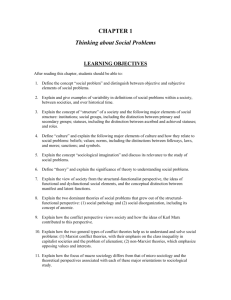
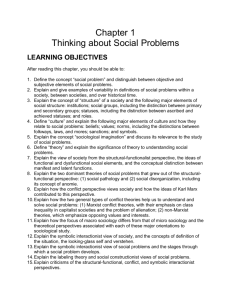
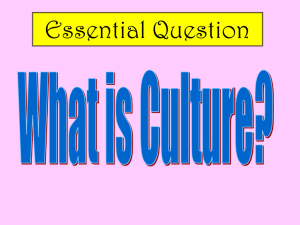
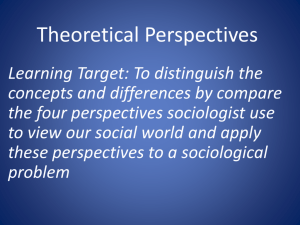
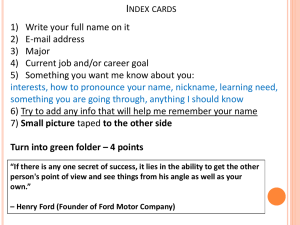
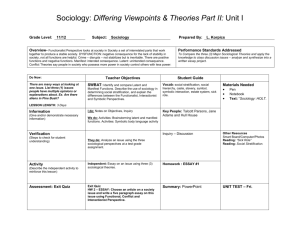
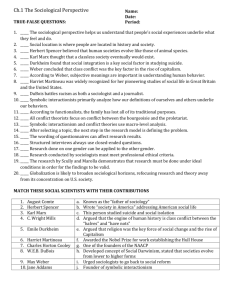
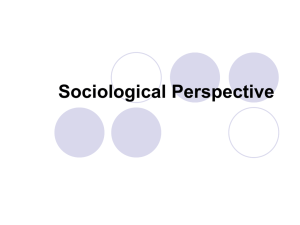
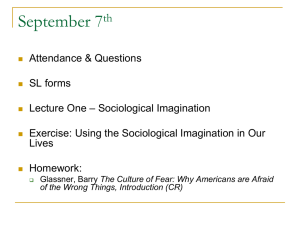
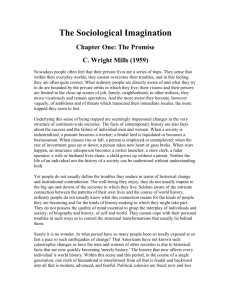
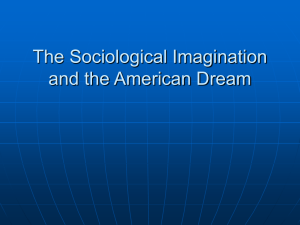

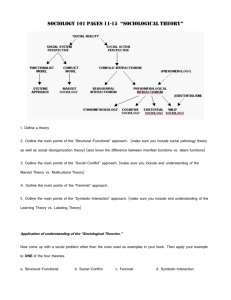

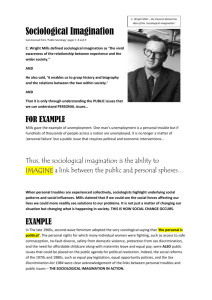
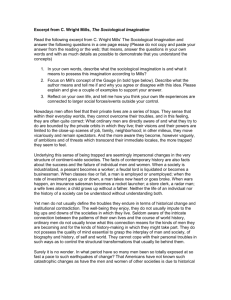
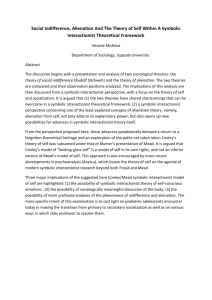
![C. Wright Mills, “The Promise [of Sociology]” Excerpt from The](http://s3.studylib.net/store/data/008348840_1-3000436459bbf066958fab311295a793-300x300.png)
